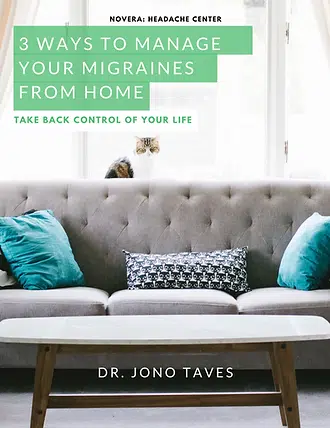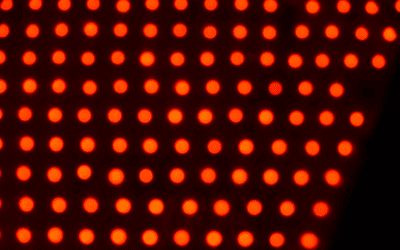Your environment can have a major impact on your headaches and migraines. Some things in our environment we have no control over. The weather, barometric pressure changes, and the intense floral perfume our coworker is wearing are all examples of this. However, there are quite a few things both in your environment and how you interact with your environment that you do have the power to control. Simply becoming mindful of these controllable factors and making a few tweaks to your day can have a huge impact on your headaches and migraines. Let’s dive into some examples.
Workspace setup
Below are some tips on how to set up your workspace to reduce poor posture and excess stress on the body while you work:
- Chair: The chair should be adjustable and provide good lower back support. It should also be at a height that allows your feet to rest flat on the floor and your knees to be at a 90-degree angle.
- Desk: The desk should be at a height that allows your forearms to be parallel to the floor when you are typing or using a mouse.
- Keyboard and Mouse: The keyboard and mouse should be positioned so that your shoulders are relaxed and your wrists are in a neutral position. A keyboard tray or wrist rest may be helpful.
- Monitor: The monitor should be at a height that allows your eyes to be level with the top of the screen, and at a distance that allows you to comfortably read the text without leaning forward.
- Lighting: The lighting should be bright enough to see the screen clearly, but not too bright or too harsh. Adjustable lamps or task lighting can be helpful.
- Take Breaks: it’s important to take regular breaks and move around, to help reduce the risk of strain and fatigue. Try not to sit in one position for more than an hour.
Lighting
Bright or fluorescent lights, or even just the glare from your computer screen, can cause eye strain and headaches. Below are some suggestions of ways you can modify your lighting to reduce the chance of light being a trigger:
- Natural light: Exposure to natural light during the day can help regulate the body’s circadian rhythm and reduce the risk of headaches. If you’re able, take a walk outside during your lunch hours or before heading into the office to start your day off right.
- Soft white light: Soft white light, such as incandescent or LED bulbs, can reduce the risk of headaches caused by bright or harsh light. If you have control over your lighting situation, consider making this switch to ease the eye strain.
- Full-spectrum light: Full-spectrum light, which mimics natural daylight, can be helpful for people who suffer from seasonal affective disorder (SAD) or other mood disorders that can cause headaches. There are lightbulbs and even desktop lamps that offer this unique feature.
- Adjustable lighting: Having adjustable lighting, such as dimmer switches or adjustable lamps, can allow you to control the intensity of the light and reduce the risk of headaches. Let’s be honest, the last thing you want when you have a headache is bright overhead lights.
Noises
Loud or persistent sounds can cause headaches, especially in people who are sensitive to noise. Sometimes it may be due to loud, sudden noises, dogs barking, or sirens going past your window. Other times, it may be that low, constant hum of the AC or a ticking clock. Having a set of earplugs or noise-canceling headphones can be a big help if you know this is a trigger. There is also some evidence to suggest that listening to binaural beats at the theta brain wave frequency may reduce migraine pain, but the research at this time is limited.
Clutter
Having a cluttered environment can cause stress and anxiety, which can lead to headaches. Feeling a bit overwhelmed looking at your space? Focus on small areas at a time to pick up or create a more minimalist space in your home to make relaxation a bit easier.
Countertop posture
It’s easy to get so caught up in cooking or cleaning that we forget to pay attention to our body mechanics or posture in the kitchen. When we’re constantly looking down, whether that be to wipe down the counters or chop up vegetables, it puts extra strain on our neck and back. See below for some tips to reduce body stress when in the kitchen:
- Keep things that you use often nearby to reduce excessive reaching and lifting.
- If you need to lift a heavy pot or pan, move your body closer to it and keep your arms tucked into your sides when able. This will reduce the strain on your muscles and allow you to use your whole body to lift the object.
- If you find that your hands and wrists bother you with excessive chopping, or that looking down for extended periods gives you neck tension, consider using a food processor to speed up the process.
Sleep
We all know how important sleep is, but a lack of it or poor quality can amplify the tension in the neck and shoulders and contribute to headaches and migraine symptoms. Here are some ways you can set yourself up for success:
- Mattress: A good quality mattress that provides proper support for your spine and neck can help reduce the risk of headaches caused by poor posture while sleeping.
- Pillows: A pillow that supports the natural alignment of your neck and spine can help reduce the risk of headaches caused by poor posture while sleeping. There are a variety of options, no matter your sleep position. We do recommend avoiding sleeping on your stomach if you have headaches or migraines due to the increased strain this position puts on your neck and shoulders.
- Room temperature: Sleeping in a room that is too hot or too cold can disrupt your rest, so it’s important to keep the room at a comfortable temperature.
- Room darkness: Sleeping in a room that is too light can impact your quality of sleep, so it’s important to have room-darkening curtains or shades to block out light. It can also be helpful to avoid looking at your phone or other electronic devices before going to sleep to support your circadian rhythm.
- Noise: Sleeping in a room that is too loud or has persistent noise can cause headaches, so it’s important to use earplugs or a white noise machine to reduce noise levels.
- Bedtime routine: Having a consistent bedtime routine, such as avoiding screens and stimulating activities before bed, can help regulate your body’s circadian rhythm and reduce the risk of headaches. Having specific habits set in place lets your brain know when it’s time to start winding down for the day so you can optimize your sleep.
Your environment can have a big impact on your headache and migraine symptoms. While there may always be some uncontrollable factors, thankfully, there are a few things you can do to make your space feel more manageable and reduce triggers. If you find yourself struggling to manage triggers or with persistent head pain that is intruding on your life, it may be time to give us a call at Novera Headache Center. Our mission is to address the root cause of your headaches and migraines to help you manage your pain without medication. We offer both in-person care and virtual coaching to provide a plan of care that meets your unique needs. Contact us today to learn more.




